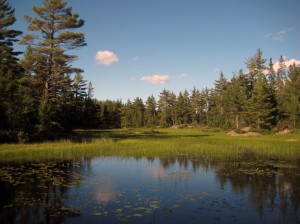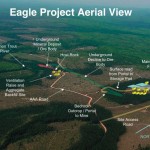My name is Kathleen Heideman, and I’m commenting tonight as a Marquette resident and tax payer, and as a Michigan citizen concerned about environmental quality. I’m also speaking on behalf of my family, which is an adjacent landowner to Rio Tinto’s Kennecott Eagle Mine site. When Rio Tinto says they want to be a “good neighbor,” they’re talking about being our neighbor.
Rio Tinto promised us a world-class mine with state-of-the-art environmental protections. The Bag House air-filter system they pledged to install was an environmental protection. According to Cynthia Pryor:
“This 65-foot-tall high stack sits within 150 feet of the Salmon Trout River. We worked hard to get the air filter included as part of Kennecott’s original air quality permit as they intended the mine exhaust to be vented directly to the air. Now, they are backpedaling and want this air filter to be removed. We are vehemently opposed to such a notion and want to make this clear…”
Let me be clear: Rio Tinto’s request to remove the air filter from their Main Vent Air Raise (MVAR) is based entirely on finances, with blatant disregard for environmental quality. It hasn’t been a good year for Rio Tinto. Perhaps tonight’s hearing should be called a “profit maximizing” permit review.
Rio Tinto wants us to believe their air filter is no longer necessary, due to changes underground, or that it would simply not be compatible with their special sort of mine. Actually, Rio Tinto wants to break this promise because air filter systems are notoriously difficult and costly to maintain. Regardless of the source or size of the emission particulates, emissions will build up on the filter, just as lint accumulates on a dryer screen, or dirt coats the air filter of a truck. Instead of discarding the filter, the bag house (depending on design) must shake, blow or electrostatically discharge the material that builds up on the filter, collecting this “caked” debris for proper treatment as a pollutant. This is a nasty cake, containing heavy metals from exhaust and sulfur-rich ore dust. Air filters fail when they develop tears in their fabric (allowing pollutants to stream through unchecked), or when moist material accumulates on the filter (reducing filter efficacy or blocking exhaust flow) or when acidic compounds in the emissions attack the filter fabric. While difficult to maintain, the whole point of installing an air filter and bag house is Process Control: avoid sending this stuff out into the environment, period.
According to their permit modification request, a mine worker will now simply stand near the MVAR stack once a day, and make a visual “observation” recording whether emissions other than water vapor from the stack are VISIBLE on a gray-scale (limit of 5% opacity). Seriously? This is an unacceptably primitive “alternative” to an air filter system.
It must be noted that Rio Tinto’s Eagle Mine proposes to have a below-ground heating system functioning most of the days per year, Spring – Fall – and Winter, whenever the outside air temperature falls below 32°. Conveniently, their heater is considered “exempt” for purposes of emissions control, so we are supposed to disregard all the hydrocarbon pollutants present in their heater emissions (which also exit the MVAR stack). In fact, the mine is proposing to increase the amount of underground heating, increasing the BTU output (and emissions) of the heaters. This mine will be heated 24-7, most of the year. Air exhausted from this mine will contain vehicle exhaust from underground mining vehicles, emissions from the heating system, and clouds of ore dust particulates released through blasting, loading, and hauling — and on most days of the year, exhausted air will be warmer than ambient air temperature. Warm, moist air — from a damp mine!
Rio Tinto had to have known from the beginning there would be condensation issues for the MVAR filter they were proposing. Any other conclusion doesn’t make sense. Condensation is a common problem, which the air filter industry routinely handles by recommending insulation and heating of the air filter bag house. Again, this increases total cost of operation. Condensation issues reduce the effective life of the air filter, whatever filter fabric is selected, which again makes the air filtration system more expensive to maintain. Added to this situation is the fact that ore dust will be sulfide-rich, creating (sulfuric) acid condensate on the air filter (as well as the MVAR and bag house equipment), leading to yet more expensive maintenance.
Clearly, Rio Tinto’s proposal to remove air filter controls from the MVAR is a cost control decision, not a pollution-control or process-control decision.
Sending an unfiltered plume of high velocity mine exhaust directly into the clean air over the Yellow Dog Plains is unconscionable. Notwithstanding the peaks of the Huron Mountains, the Yellow Dog Plains are the height of land for Marquette County. There has never been heavy industry in this location, but according to Rio Tinto’s air pollution dispersal maps (based on dubious weather models unconnected to the Yellow Dog Plains), mine pollution will soon be raining down over half of Marquette County. The unfiltered particulates they propose to send into our skies will be blanketing the blueberries we harvest, changing the PH of our lichen-covered soils (destroying these lichen, which are highly sensitive to acid rain), damaging the ecosystems of the Huron Mountains and Silver Lake Basin, accumulating in the watersheds of the Salmon Trout River, Yellow Dog River and countless wild streams, and contaminating our air with particulates that present an inhalation hazard for humans and wildlife. Rio Tinto may plan on issuing dust masks to employees at the mine, but they certainly won’t be handing them out to deer hunters, berry pickers, the deer and moose and wolves, or anyone with camps on the Yellow Dog, or homes in the Big Bay area. We all deserve clean air to breathe.
It is curious to note: Rio Tinto states in their Permit that they may need to change underground operations to respond to economic considerations, which are “constantly changing”:
“The underground ore handling system is based upon “best facility economics. Because economics are constantly changing due to market conditions, changes to the underground ore handling system may be necessary to reflect future market conditions.”
Of course, another factor that is “constantly changing” is industrial technology and the best facility practices related to process control and air pollution abatement measures! Curiously, the permit makes no mention of changing practices to align with future environmental practices.
Rather than use a filter system, Rio Tinto proposes to spray water inside the mine. Spraying groundwater on air-polluting dust? That’s a 19th century bandage, not a pollution control. Rio Tinto’s “solution” to air pollution assumes that Michigan groundwater is endlessly available, free for the taking, and unconnected to aquifers supplying drinking water to surrounding residents of Marquette County. Those assumptions are unacceptable.
Rio Tinto repeatedly promised to build a world-class mine, using world-class technology, and world-class safety practices. Was that a bait and switch strategy? If they made an empty promise, regarding their MVAR air filter, the Eagle Mine permit was fraudulent.
If allowed, Rio Tinto’s permit modification would allow the mine to spew an unfiltered plume of air pollution for the winds to disperse over Marquette County. The “Solution to Pollution is not Dilution” – that was 19th century approach. Rio Tinto received a mine permit from the DEQ because of environmental assurances they made, including the MVAR’s filter.
They do not have free license to pollute Michigan’s air and water. Please deny this permit modification on the grounds that it is based on economic considerations and terrible science, and will functionally increase both air and water pollution.
While the air filtration system Rio Tinto proposed will be expensive to implement and difficult to maintain, such control measures are essential, not optional. Clean air is priceless.
Kathleen M. Heideman
Marquette MI 49855


